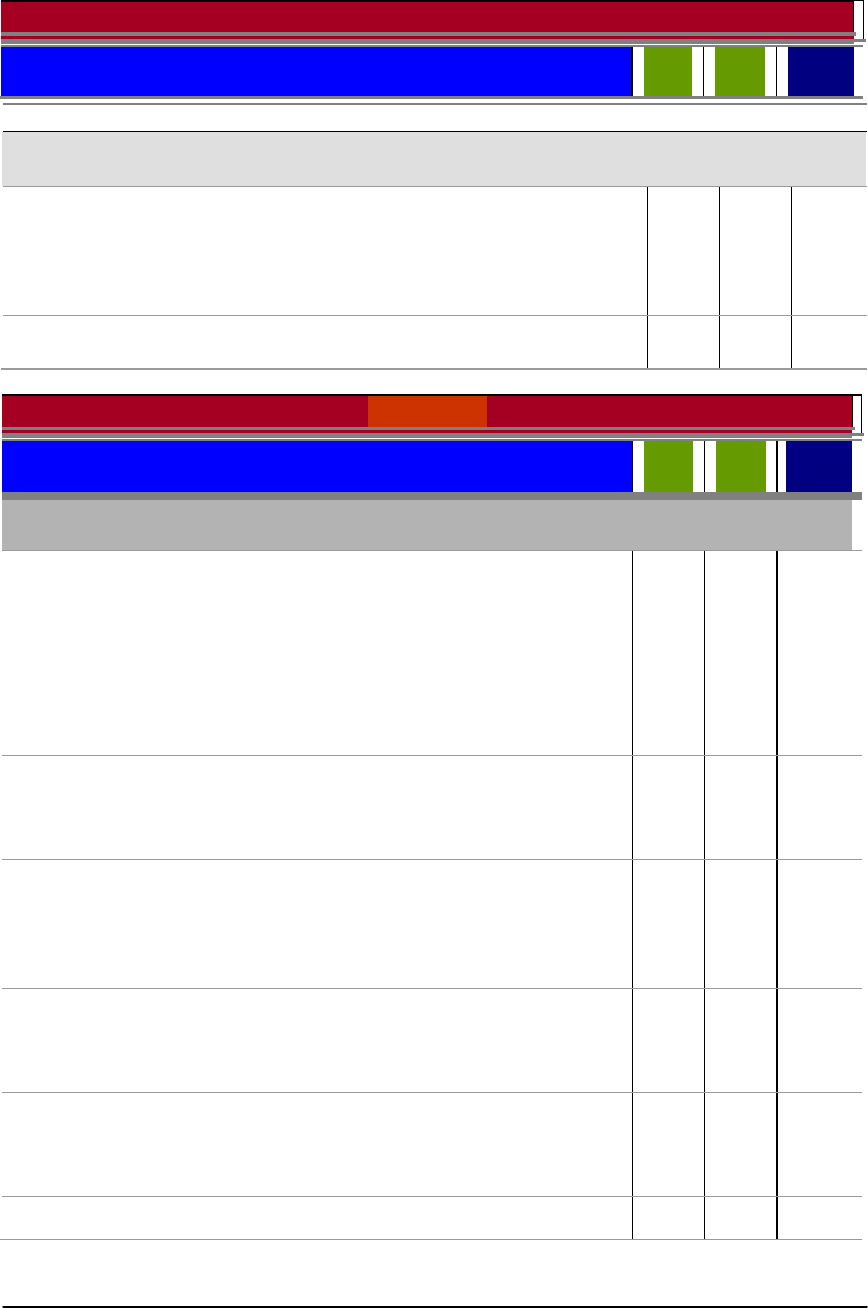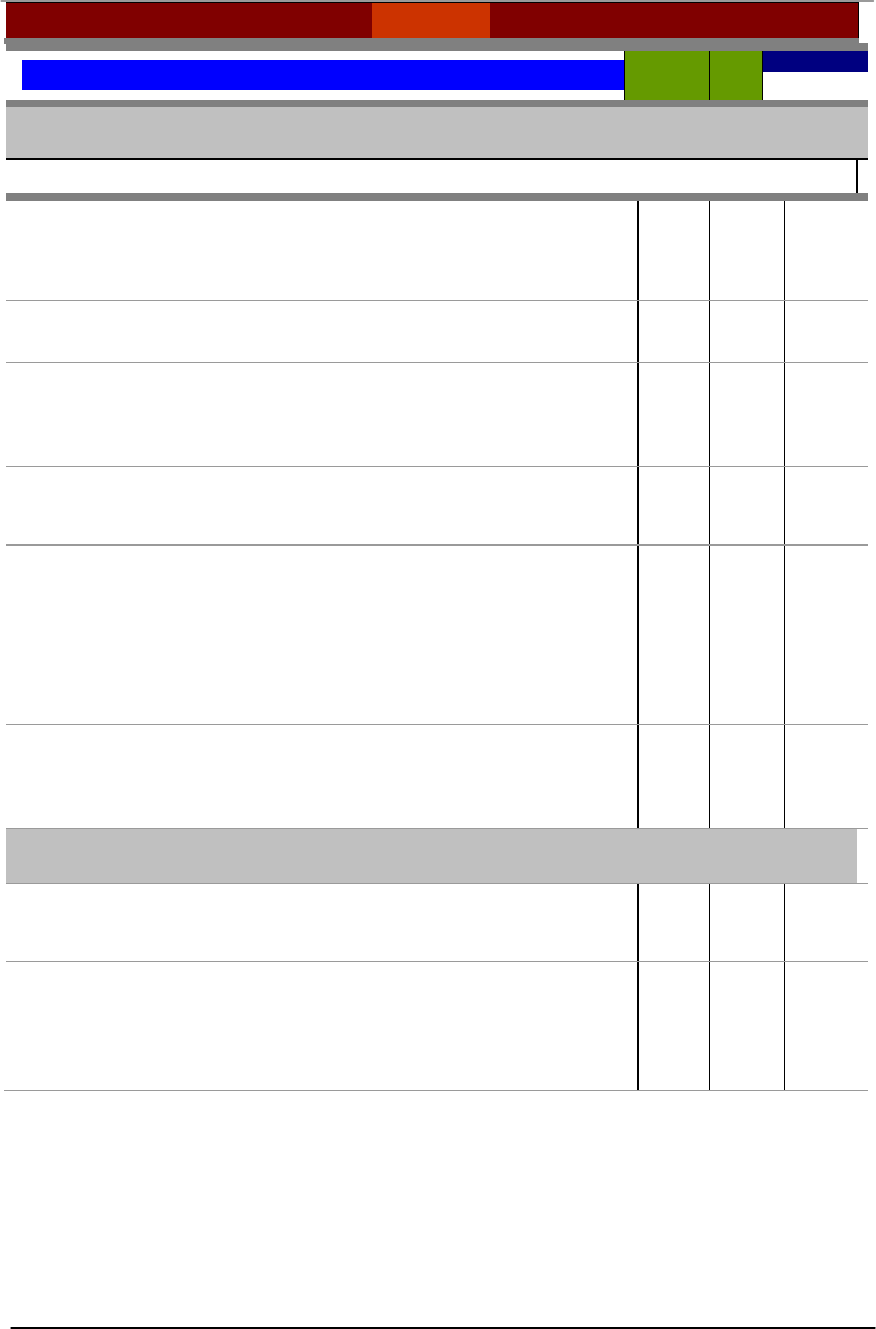
NATIONAL PLAN TO ACHIEVE
MARITIME DOMAIN AWARENESS
FOR
THE NATIONAL STRATEGY FOR MARITIME SECURITY
OCTOBER 2005

National Strategy for Maritime Security: National Plan to Achieve Maritime Domain Awareness
i
FOREWORD
By signing National Security Presidential Directive-41/Homeland Security Presidential
Directive-13 (NSPD-41/HSPD-13) (Maritime Security Policy, December 21, 2004)
President Bush underscored the importance of securing the Maritime Domain, which is
defined as "All areas and things of, on, under, relating to, adjacent to, or bordering on a
sea, ocean, or other navigable waterway, including all maritime-related activities,
infrastructure, people, cargo, and vessels and other conveyances.” NSPD-41/HSPD-13
established a Maritime Security Policy Coordinating Committee—the first coordinating
committee tasked specifically to address this issue—to oversee the development of a
National Strategy for Maritime Security and eight supporting implementation plans:
National Plan to Achieve Maritime Domain Awareness lays the foundation for an
effective understanding of anything associated with the Maritime Domain that could impact
the security, safety, economy, or environment of the United States and identifying threats as
early and as distant from our shores as possible.
Global Maritime Intelligence Integration Plan uses existing capabilities to integrate all
available intelligence regarding potential threats to U.S. interests in the Maritime Domain.
Maritime Operational Threat Response Plan aims for coordinated U.S. Government
response to threats against the United States and its interests in the Maritime Domain by
establishing roles and responsibilities, which enable the government to respond quickly and
decisively.
International Outreach and Coordination Strategy provides a framework to coordinate
all maritime security initiatives undertaken with foreign governments and international
organizations, and solicits international support for enhanced maritime security.
Maritime Infrastructure Recovery Plan recommends procedures and standards for the
recovery of the maritime infrastructure following attack or similar disruption.
Maritime Transportation System Security Plan responds to the President’s call for
recommendations to improve the national and international regulatory framework regarding
the maritime domain.
Maritime Commerce Security Plan establishes a comprehensive plan to secure the
maritime supply chain.
Domestic Outreach Plan engages non-Federal input to assist with the development and
implementation of maritime security policies resulting from NSPD-41/HSPD-13.
Although these plans address different aspects of maritime security, they are mutually
linked and reinforce each other. Together, the National Strategy for Maritime Security
and its supporting plans represent a comprehensive national effort to enhance the security
of the United States by preventing hostile or illegal acts within the Maritime Domain.
These plans do not alter existing constitutional or statutory authorities or responsibilities
of the department and agency heads to carry out operational activities or to provide or
receive information.

National Strategy for Maritime Security: National Plan to Achieve Maritime Domain Awareness
ii
EXECUTIVE SUMMARY
“The heart of the Maritime Domain Awareness program is accurate information,
intelligence, surveillance, and reconnaissance of all vessels, cargo, and people extending
well beyond our traditional maritime boundaries.”
PRESIDENT BUSH
JANUARY 20, 2002
Maritime Domain Awareness (MDA) is the effective understanding of anything
associated with the global maritime domain that could impact the security, safety,
economy, or environment of the United States. MDA is a key component of an active,
layered maritime defense in depth. It will be achieved by improving our ability to
collect, fuse, analyze, display, and disseminate actionable information and intelligence to
operational commanders. MDA is supported by the Global Maritime Intelligence
Integration Plan and is the enabler for the Maritime Operational Threat Response Plan.
This plan advocates enhanced and innovative collection of intelligence, the integration of
correlated open source information, and the incorporation of automated algorithms to
assist human analytic efforts. The National Maritime Intelligence Center will be the
central point of connectivity to fuse, analyze, and disseminate information and
intelligence for shared situational awareness across classification boundaries.
To achieve persistent awareness in the maritime domain, Cold War legacy collection
capabilities alone are no longer sufficient. We must reorient and integrate these legacy
systems with current and emerging capabilities, such as unmanned aerial vehicles and
acoustic sensors, fused in a common operating picture available to maritime operational
commanders and accessible throughout the United States Government. Employment of
these collection capabilities will maximize near-real time awareness of maritime threats.
Stand-off detection capabilities for weapons of mass destruction in the maritime domain
must be developed to complement existing and emerging cargo inspection systems and
hand-held detection devices. Most significantly, human intelligence collection and the
investigative actions of law enforcement officers can provide crucial insights about
maritime threats.
The primary method for information sharing, situational awareness, and collaborative
planning will be the national maritime common operating picture (COP). The COP is a
near-real time, dynamically tailorable, network-centric virtual information grid shared by
all U.S. Federal, state, and local agencies with maritime interests and responsibilities.
COP data will be accessible to all users, except when limited by security, policy, or
regulations.
Successful execution of this plan requires a sustained and adaptive national effort.
Critical to this effort is the coordination and collaboration of the Federal, state, local,
tribal and international partners as well as the private sector. An Implementation Team is

National Strategy for Maritime Security: National Plan to Achieve Maritime Domain Awareness
3
established to implement this Plan and follow-on MDA supporting plans. Ultimately, the
backbone of protecting the United States from maritime threats is an active, layered
defense. MDA is the critical link to achieving this effective defense through persistent
awareness and decision superiority. The National Plan to Achieve Maritime Domain
Awareness will make the United States more secure.

National Strategy for Maritime Security: National Plan to Achieve Maritime Domain Awareness
4
TABLE OF CONTENTS
FOREWORD ................................................................................................................................................. i
EXECUTIVE SUMMARY .......................................................................................................................... ii
TABLE OF CONTENTS ............................................................................................................................ iv
I. Context ................................................................................................................................................ 1
PURPOSE OF THE PLAN .......................................................................................................................... 1
KEY DEFINITIONS ................................................................................................................................. 1
STRATEGIC ENVIRONMENT ................................................................................................................... 2
MDA Goals .......................................................................................................................................... 2
MDA Objectives ................................................................................................................................... 2
Guiding Principles ............................................................................................................................... 3
Planning Assumptions .......................................................................................................................... 4
Threats ................................................................................................................................................. 5
KEY ORGANIZATIONS ........................................................................................................................... 5
Governmental Organizations ............................................................................................................... 5
International Organizations ................................................................................................................. 6
Private Sector Organizations ............................................................................................................... 6
II. Effective Decision-making ................................................................................................................. 7
TERMS OF REFERENCE .......................................................................................................................... 8
KNOWLEDGE CAPABILITIES .................................................................................................................. 9
KNOWLEDGE DEVELOPMENT .............................................................................................................. 10
UNDERSTANDING .................................................................................................................................11
III. Priorities ............................................................................................................................................13
INFORMATION AND STANDARDS ......................................................................................................... 13
Enhance Information Collection .........................................................................................................13
Share Information ...............................................................................................................................14
Set Standards ..................................................................................................................................... 15
TECHNOLOGY ......................................................................................................................................15
Sensors and Platforms ........................................................................................................................15
Communications .................................................................................................................................16
Information Exploitation .....................................................................................................................16
ORGANIZATIONS AND PERSONNEL ...................................................................................................... 17
IV. Implementation .................................................................................................................................18
ORGANIZATIONAL AND POLICY CHANGES .......................................................................................... 18
Plan Execution ....................................................................................................................................18
Resource Implications .........................................................................................................................18
Actions ................................................................................................................................................19
V. Conclusion .........................................................................................................................................20
Appendix A: Acronyms and Terms ....................................................................................................... A-1
Appendix B: Near and Long-Term Priorities ....................................................................................... B-1

National Strategy for Maritime Security: National Plan to Achieve Maritime Domain Awareness
1
I. CONTEXT
Seafarers have sought an understanding of the oceans for centuries. The United States has
relied upon technology to collect data in this environment. Today’s complex and
ambiguous threats place an even greater premium on knowledge and a shared
understanding of the maritime domain. Adequately addressing these threats requires
effective and superior decision-making. Decision superiority is enabled by ensuring global
maritime information dominance through the collection, integration and dissemination of
information and intelligence, and the development of knowledge. An effective
understanding of the global maritime domain enables focused law enforcement and military
action, supports strategic decision-making and operational threat response while promoting
freedom, civil liberties, and prosperity for all. This Plan supports the strategic objectives
and elements of the National Strategy for Maritime Security (NSMS), which emphasizes
“the ability to know, so that preemptive or interdiction actions may be taken as early
as possible.” In addition, implementing this plan directly supports the Global Maritime
Intelligence Integration and Maritime Operational Threat Response Plans tasked by the
Presidential Directive on Maritime Security Policy (NSPD-41/HSPD-13).
PURPOSE OF THE PLAN
The National Plan to Achieve Maritime Domain Awareness is a cornerstone for successful
execution of the security plans tasked in NSPD-41/HSPD-13. This Plan serves to unify
United States Government and support international efforts to achieve MDA across the
Federal government, with the private sector and civil authorities within the United States,
and with our allies and partners. It directs close coordination of a broad range of federal
departments and agencies for this lasting endeavor. Implementation of this Plan will be
conducted under the oversight of an interagency implementation team.
KEY DEFINITIONS
Maritime Domain is all areas and things of, on, under, relating to, adjacent to, or bordering
on a sea, ocean, or other navigable waterway, including all maritime related activities,
infrastructure, people, cargo, and vessels and other conveyances.
Maritime Domain Awareness is the effective understanding of anything associated with
the maritime domain that could impact the security, safety, economy, or environment of the
United States.
Global Maritime Community of Interest (GMCOI) includes, among other interests, the
federal, state, and local departments and agencies with responsibilities in the maritime
domain. Because certain risks and interests are common to government, business, and
citizen alike, community membership also includes public, private and commercial
stakeholders, as well as foreign governments and international stakeholders.

National Strategy for Maritime Security: National Plan to Achieve Maritime Domain Awareness
2
STRATEGIC ENVIRONMENT
There are few areas of greater strategic importance than the maritime domain. The oceans
are global thoroughfares that sustain our national prosperity and are vital for our national
security. Distinct from other domains (e.g., air and space), the maritime domain provides
an expansive pathway through the global commons. Terrorist organizations recognize this,
and also realize the importance of exploiting the maritime domain for financial gain and
movement of equipment and personnel, as well as a medium for launching attacks. The
maritime domain presents a broad array of potential targets that fit terrorists’ operational
objectives of achieving mass casualties and inflicting economic harm.
The basis for effective prevention measures is awareness and threat knowledge, along with
credible deterrent and interdiction capabilities. Without effective understanding of
maritime domain activities, gained through persistent awareness, vital opportunities for an
early response can be lost. Awareness grants time and distance to detect, deter, interdict,
and defeat adversaries. The maritime threat environment of the 21
st
Century requires
broader scope and a more comprehensive vision. We must look beyond traditional
surveillance of ports, waterways, and oceans, and continuously adapt to new challenges and
opportunities. We must set priorities for existing and developing capabilities to efficiently
minimize risks while contending with an uncertain future. Our understanding of the
maritime domain must incorporate intelligence originally acquired in overseas land areas
and domestic law enforcement and intelligence information. MDA provides operational
maritime commanders a near-real time ability to defeat hostile nation and transnational
terrorist threats.
MDA Goals
MDA supports core national defense and security priorities over the next decade. MDA
serves to simplify today’s complex and ambiguous security environment by meeting the
following strategic goals:
Enhance transparency in the maritime domain to detect, deter and defeat
threats as early and distant from U.S. interests as possible;
Enable accurate, dynamic, and confident decisions and responses to the full
spectrum of maritime threats; and
Sustain the full application of the law to ensure freedom of navigation and the
efficient flow of commerce.
MDA Objectives
Achieving MDA depends on the ability to monitor activities in such a way that trends can
be identified and anomalies differentiated. Data alone are insufficient. Data must be

National Strategy for Maritime Security: National Plan to Achieve Maritime Domain Awareness
3
collected, fused, and analyzed, preferably with the assistance of computer data integration
and analysis algorithms to assist in handling vast, disparate data streams, so that operational
decision makers can anticipate threats and take the initiative to defeat them. The following
objectives constitute the MDA Essential Task List, which will guide the development of
capabilities that the United States Government will pursue and when executed will provide
the GMCOI an effective understanding of the maritime domain.
Persistently monitor in the global maritime domain:
o Vessels and craft
o Cargo
o Vessel crews and passengers
o All identified areas of interest
Access and maintain data on vessels, facilities, and infrastructure
Collect, fuse, analyze, and disseminate information to decision makers to
facilitate effective understanding.
Access, develop and maintain data on MDA-related mission performance.
Achieving the essential tasks will make MDA the critical enabler for national maritime
security and enable effective decision-making for United States Government maritime
operational threat responses. The pursuit of the goals and objectives outlined above will
be guided by the following principles and assumptions.
Guiding Principles
The first step towards meeting these principles is to ensure GMCOI stakeholders, at
all levels, know what they can do to help, how they can do it and, most importantly
why Maritime Domain Awareness is in their collective best interest. The openness
of American society and the structure of our traditional governance argue against
Persistently Monitor The integrated management of a diverse set of collection
and processing capabilities, operated to detect and understand the activity of
interest with sufficient sensor dwell, revisit rate, and required quality to
expeditiously assess adversary actions, predict adversary plans, deny sanctuary
to an adversary, and assess results of U.S./coalition actions. “Persistently
monitor” in this Plan refers to an ability to conduct persistent monitoring
anywhere on the globe. It is not meant to imply that we can simultaneously do
persistent monitoring over the entire globe.

National Strategy for Maritime Security: National Plan to Achieve Maritime Domain Awareness
4
centralizing all aspects of MDA within an expanded federal infrastructure.
However, it will demand a common purpose and agreed upon procedures.
Unity of Effort. MDA requires a coordinated effort within and among the GMCOI,
including public and private sector organizations, and international partners. The need
for security is a mutual interest requiring the cooperation of industry and government.
Information Sharing and Integration. MDA depends upon unparalleled information
sharing. MDA must have protocols to protect private sector proprietary information.
Bilateral or multilateral information sharing agreements and international conventions
and treaties will be MDA enablers.
The primary method for information sharing is the national maritime common
operational picture (COP). The COP is a near-time, dynamically tailorable, network-
centric virtual information grid shared by all U.S. Federal, state, and local agencies with
maritime interests and responsibilities. COP data will be accessible to all users, except
when limited by security, policy, or regulations. The COP also contains decision-maker
toolsets fed by one or more distributed and exchanged object and track databases to
facilitate collaborative planning and assist all echelons in achieving situational
awareness. Each user can filter and contribute to these databases according to his or her
information needs, responsibilities, and level of access.
Safe and Efficient Flow of Commerce. Public safety and economic security are
mutually reinforcing. All members of the GMCOI must recognize that the safe and
efficient flow of commerce is enhanced and harmonized by an effective understanding of
the maritime domain. The converse is also true, that MDA is enhanced by responsible
participation in an accountable system of commerce. The two concepts are mutually
reinforcing.
Planning Assumptions
The Plan makes the following assumptions:
Federal, state, local, tribal, private sector, and international partners will
participate;
Existing systems and capabilities will be leveraged and integrated;
The need for security will be harmonized with the imperative to preserve
fundamental liberties, freedom of navigation, and the legitimate use of the seas for
commercial and recreational purposes;
All maritime stakeholders will take a collaborative approach to establish
unprecedented information exchange and pooling of resources; and
International participation in maritime security activities including information
sharing with other states or acting against threats remains voluntary for each
nation.

National Strategy for Maritime Security: National Plan to Achieve Maritime Domain Awareness
5
Threats
The variety of maritime domain threats include:
Nation-State Threats. The prospect of major regional conflicts erupting,
escalating, and drawing in major powers should not be discounted. Nonetheless,
for the near-term, states represent a more significant challenge to global security.
Some states of concern provide safe havens for criminals and terrorists, who use
these countries as bases of operations to export illicit activities into the maritime
domain and into other areas of the globe. The probability of a rogue government
using a WMD is expected to increase during the next decade. An even greater
danger is that a state of concern will provide critical advanced conventional
weaponry, WMD components, delivery systems and related materials,
technologies and weapons expertise to another rogue state or a terrorist
organization that is willing to conduct WMD attacks. This is of the greatest
concern since the maritime domain is the likely venue by which WMD will be
brought into the United States.
Terrorist Threats. The vastness of the maritime domain provides great
opportunities for exploitation by terrorists. The use of smaller commercial and
recreational vessels closer to our shores and areas of interest to transport WMD/E
is of significant concern. Additionally, terrorists can use large merchant ships to
move powerful conventional explosives or WMD/E for detonation in a port or
alongside an offshore facility. Terrorist groups have demonstrated a capacity to
use shipping as a means of conveyance for positioning their agents, logistics
support, and revenue generation. Terrorists have shown that they have the
capability to use explosives-laden suicide boats as weapons. This capability could
easily be used with merchant ships as kinetic weapons to ram another vessel,
warship, port facility, or offshore platforms.
Transnational Criminal and Piracy Threats. Modern-day pirates and other
criminals are well organized and well equipped, often possessing advanced
communications, weapons, and high-speed craft to conduct smuggling of people,
drugs, weapons, and other contraband, as well as piracy.
Environmental and Social Threats. Catastrophic destruction of marine
resources, conflict between nation-states over maritime resources, and mass
migration flows have the potential to harm the maritime domain or destabilize
regions of the world. The accompanying economic impacts are often significant.
Governmental Organizations
KEY ORGANIZATIONS
The Maritime Security Policy Coordinating Committee (MSPCC), established by NSPD-
41/HSPD-13 and co-chaired by representatives from the NSC and HSC staffs, is the
primary forum for coordinating and implementing policies, strategies, and initiatives of
this plan. Both through the MSPCC and other organizational implementation efforts, the

National Strategy for Maritime Security: National Plan to Achieve Maritime Domain Awareness
6
United States Government will work with relevant intergovernmental, state, and local
agencies, as well as private sector and international partners, to execute this plan.
International Organizations
MDA must be embedded into all maritime activities to enhance global maritime security.
Close, continual cooperation with international organizations is required to achieve
MDA. For example, the International Maritime Organization (IMO) took steps toward
embedding security within the global maritime domain with the adoption of the
International Ship and Port Facility Security (ISPS) code. This provides a standardized,
consistent framework for evaluating risk, enabling governments to offset changes in
threat with changes in vulnerability for ships and port facilities. To help facilitate global
MDA, this plan will leverage the efforts of the NSMS International Outreach and
Coordination Strategy, which provides a framework to coordinate all maritime security
initiatives undertaken with foreign governments and international organizations, and
solicits international support for enhanced maritime security.
Private Sector Organizations
Initiatives conducted with the support of the private sector are also necessary to ensure
full information dominance in the maritime domain. Public-private sector partnership
initiatives, such as the Customs-Trade Partnership Against Terrorism (C-TPAT), provide
models for enhancing awareness and incentives for private sector participation. Such
initiatives have helped enhance the visibility and security of the global supply chain, a
key element of MDA. To this end, we must engage private sector organizations to
include: Harbor Safety Committees, shipping companies, associations and consortia
within the GMCOI, including the National Maritime Security Advisory Committee
(NMSAC) and other private sector advisory committees.

National Strategy for Maritime Security: National Plan to Achieve Maritime Domain Awareness
7
II. EFFECTIVE DECISION-MAKING
“America, in this new century, again faces new threats. Instead of massed armies, we
face stateless networks; we face killers who hide in our own cities. We must confront
deadly technologies. To inflict great harm on our country, America's enemies need to be
only right once. Our intelligence and law enforcement professionals in our government
must be right every single time.”
PRESIDENT BUSH
DECEMBER 17, 2004
The purpose of MDA is to facilitate timely, accurate decision-making. MDA does not
direct actions, but enables them to be done more quickly and with precision. MDA is
achieved by (1) collecting, analyzing and disseminating data, information and
intelligence to decision makers, and (2) applying functional and operational knowledge in
the context of known and potential threats. A United States Government MDA capability
that is integrated, interoperable, and efficient, coupled with continually improving
knowledge is required to meet today’s mission requirements. Figure 1 demonstrates
the interaction between capabilities, knowledge development, and their collective
contribution to understanding and effective decision-making.

National Strategy for Maritime Security: National Plan to Achieve Maritime Domain Awareness
8
Effective
Understanding
D
D
e
e
c
c
i
i
s
s
i
i
o
o
n
n
S
S
u
u
p
p
e
e
r
r
i
i
o
o
r
r
i
i
t
t
y
y
i
i
n
n
t
t
h
h
e
e
M
M
a
a
r
r
i
i
t
t
i
i
m
m
e
e
D
D
o
o
m
m
a
a
i
i
n
n
Decision Making
Knowledge Capabilities
Knowledge Development
Information
Intelligence
Operational
Knowledge
Data
Surveillance &
Reconnaissance
Priorities
Functional
Knowledge
Actionable
Intel
Figure 1
TERMS OF REFERENCE
Data.
1
Representation of facts, concepts, or instructions in a formalized manner suitable
for communication, interpretation, or processing by humans or by automatic means. Any
representations such as characters or analog quantities to which meaning is or might be
assigned.
Information. Facts, data, or instructions in any medium or form. The meaning that a
human assigns to data by means of the known conventions used in their representation.
Intelligence. The product resulting from the collection, processing, integration, analysis,
evaluation, and interpretation of available information concerning foreign countries or
areas. Information and knowledge about an adversary obtained through observation,
investigation, analysis, or understanding.
Knowledge.
2
Familiarity or awareness gained through experience or study. The sum or
range of what has been perceived, discovered, or learned.
1
Definitions for Data, Information, and Intelligence adopted from the DoD Dictionary of Military and
Associated Terms (Joint Pub 1-02)
2
Definition for Knowledge adopted from the Joint Forces Command (JFCOM) Glossary of Terms

National Strategy for Maritime Security: National Plan to Achieve Maritime Domain Awareness
9
Understanding. Ability to comprehend the sense or meaning of something based on the
application of knowledge against data, information, and intelligence.
By delivering these elements in a manner quickly and easily comprehended, MDA
shortens decision cycles and enables decisive operational response.
KNOWLEDGE CAPABILITIES
Understanding the maritime domain will result from the employment of traditional
intelligence capabilities and processes fed by, and synchronized with, operational
decision-making processes. The collection, fusion, analysis and dissemination of
prioritized categories of maritime intelligence and all-source information are the
fundamental building blocks of MDA.
The global maritime domain includes a wide variety of interlocking and connected
systems operating within, adjacent to and beyond the physical oceans and waterways that
must be brought into better focus. Detecting and interdicting threats within a system that
crosses domestic and international jurisdictions requires a persistent awareness.
Intelligence, Surveillance and Reconnaissance (ISR) capabilities are required in a
layered approach that provides more comprehensive awareness of threats and
illegal activities as they approach the United States.
Achieving MDA requires integration of data, information and intelligence from a broad
range of sources, categorized as follows:
Vessels—characteristics such as flag, type, tonnage, maximum speed, origin, and
track
Cargo—from a vessel’s manifest, shipment origin, human intelligence (HUMINT),
or as input from chemical/biological/nuclear/radiation/explosive detection sensors
Vessel crews and passengers—to include crew, dockworkers, and passengers
Maritime Areas of Interest—a focusing of surveillance capabilities to particular
geographic points such as sea lanes or oceanic regions
Ports, waterways, and facilities - port terminals, piers, cranes, petrol facilities, and
other characteristics
The Environment - weather, currents, natural resources, fish stocks
Maritime Critical Infrastructure – nuclear power plants, rail heads, transportation
nodes, bridges, and undersea fiber optic cables and pipelines
Threats and Activities - identified threats and inherently dangerous activities such as
illegal migration, drug smuggling, or offshore drilling
Friendly Forces – operational information on military, federal, state, local, and/or
allied assets operating in the maritime domain
Financial Transactions - illegal money trails, hidden vessel or cargo ownership
Of the above categories, priority is placed on the data, information, and intelligence
associated with people, cargo, and vessels engaged in maritime activities. The

National Strategy for Maritime Security: National Plan to Achieve Maritime Domain Awareness
10
potential for exploitation in these areas makes them the most critical priorities of
information and intelligence collection.
To meet emerging threats, MDA may be required to support the entire spectrum of
national security events – from the Global War on Terrorism and stability operations to
disaster response and recovery. These requirements may call for a surge or sustained
capability to provide MDA where strategically, operationally, or tactically most
important. In these cases, capabilities supporting MDA will be focused toward identified
maritime areas of interest, such as military vessels or formations, the center of a maritime
operating area or a geographic area of interest (e.g., choke point, special security events,
sea lines of communication, strategic port, high threat area, etc.).
KNOWLEDGE DEVELOPMENT
Knowledge capabilities alone will not ensure effective decision-making. Information and
intelligence becomes actionable only when decision makers are equipped with knowledge
and are positioned to act. Developing the ability to know, so that immediate or deliberate
actions may be taken at the time and place of our choosing requires a dedicated and
sustained effort to develop a dynamic knowledge base.
This Plan focuses on two critical pillars of knowledge development directed towards
decision-making.
Functional knowledge is “expert” knowledge. Functional knowledge is gained
primarily through traditional academic study. Experts assigned to a particular field or
operating area possess this type of knowledge.
Operational knowledge is based on action and experience. Decision makers and
supporting staffs gain this knowledge on the basis of situational experience learned
through real-world case prosecution or effective exercise and training programs.
Knowledge development, particularly operational knowledge, depends on a continuous
and active feedback mechanism. Each decision will have consequences and a desired
outcome. These results must be evaluated and lessons applied to MDA priorities and
capabilities, and knowledge development. Nowhere is the interaction with a broad cross-
section of federal, state, public and private, and international partners more important
than in the application of knowledge. Federal agencies must tap into the significant
reservoirs of functional and operational knowledge at every echelon of decision-making
in order to enhance their ability to make the right decisions at the right time. Initiatives
such as virtual and established Lessons Learned Centers of Excellence as well as the
development of training and exercise programs will be pursued. Doing so will help
ensure the United States is positioned to take early and effective action against the entire
spectrum of maritime threats. Figure 2 contains an example of knowledge development
in action.

National Strategy for Maritime Security: National Plan to Achieve Maritime Domain Awareness
11
UNDERSTANDING
Effective understanding is the synthesis of national capabilities and knowledge
development that will produce the level of understanding required to insure effective
decision-making. Priority must be placed on, and continually validated by decision
maker requirements. The potential for MDA as a force multiplier by shortening decision
cycles and enabling timely operational responses rests in its ability to deliver information
in a manner useful and executable by decision makers.

National Strategy for Maritime Security: National Plan to Achieve Maritime Domain Awareness
12
Knowledge Development: U.S. embassy in Europe passes that an informant has reported an attempt to
smuggle an improvised nuclear device (IND) on a cargo vessel enroute the United States. Some details such as
the approximate date and probable port of debarkation are provided, but the vessel name and U.S. destination
are unknown.
Information: A general service cargo vessel en route the United States files Electronic Notice of Arrival
(ENOA) with USCG/CBP.
Decision: Senior U.S. officials decide that the threat is serious, and that government assets must identify, track,
and interdict the vessel. DOD is given the lead to in accordance with the Maritime Operational Threat
Response Plan.
Operational Knowledge of the threat is disseminated to the Global Maritime Community of Interest via COP.
CBP readjusts targeting criteria to reflect the new threat. The Automated Targeting System (ATS) identifies an
anomaly in the cargo manifest of the reporting vessel.
Decision: The National Targeting Center selects the vessel for further inspection and reviews the cargo
manifest in detail as well as the crew/passenger list in the Advanced Passenger Information System. The
vessel’s Automated Information System (AIS) track in the COP is “flagged.”
Knowledge Capabilities: Analysts determine there are 32 possible suspect vessels given the time frame and
port of debarkation. Joint Operational Intelligence Center analysts note the flagged vessel had called at the port
of debarkation in the correct time frame and designate the ship a VOI. Additional HUMINT validates that
the VOI is indeed suspect and national assets are refocused to verify VOI’s location.
Knowledge: COP reveals the closest asset capable of at‐sea interdiction is a Coast Guard cutter on routine
operations. CBP asks carrier, a C‐TPAT partner, to provide ship layout. Ship layout and most probable
location of suspect cargo are provided to the cutter and COCOM via the COP.
Knowledge: At COCOM request, National Weather Service generates updated weather forecasts for
interdiction area and provides predictions of long‐range dispersion of nuclear contaminants in case of release
of the IND, which is provided via the COP.
Knowledge Development: The vessel is interdicted in accordance with the Maritime Operational Threat
Response Plan. Material is seized and the information gained provides knowledge that leads to future
investigation.
Knowledge Enablers support every step of this process. Information architecture allows for knowledge to be
disseminated across the ocean via the net‐centric, common operating picture, and for data to be transmitted to
analysts from space. Multi‐level security allows for the sharing of knowledge across security classifications
and between agencies using shared situational awareness. Without these enablers, it would be impossible to
complete the knowledge cycle and achieve MDA.
Figure 2

National Strategy for Maritime Security: National Plan to Achieve Maritime Domain Awareness
13
III. PRIORITIES
MDA is supported by cross-cutting Knowledge Capabilities that streamline the
Knowledge Development process and enable the identification of Knowledge
Requirements to support effective decision-making. To facilitate implementation of this
plan, efforts to enhance Knowledge Capabilities or Development processes are grouped
into three general priority areas: Information and Standards, Technology, and
Organizations and Personnel (see Table 1). Detailed in Appendix B, these areas address
identified MDA needs that support fulfillment of the MDA Essential Tasks.
Priorities
Actions
Information and
Standards
Enhance Information Collection
Share Information
Set Standards
Technology
Sensors and Platforms
Communications
Information Exploitation
Organizations
and Personnel
Building Coalitions and Partnerships
Human Intelligence Collection
Global Maritime Community Of Interest (GMCOI)
Development
Integrated National‐Level Maritime Command Centers
for Maritime Operational Threat Response
Table 1
INFORMATION AND STANDARDS
It is critical for the United States to integrate security activities with partners at home and
allies abroad. To this end, the United States Government will support, develop, direct
and implement policies, procedures, agreements, and standards at the international,
federal, state, local and tribal levels to enhance collection, develop flexible integration
systems, and provide access to information for timely support to decision-makers,
operators, and first responders.
Enhance Information Collection
Ensure the United States Government has greater transparency into the supply chain
through industry submission of accurate, advance electronic cargo information in
compliance with the Trade Act and participation in the Customs-Trade Partnership
Against Terrorism (C-TPAT)
Identify, develop, and deploy new detection and surveillance technologies across
North America through the Security and Prosperity Partnership for North America
Coordinate with international organizations to expand information requirements for
data such as Advance Notice of Arrival (ANOA).

National Strategy for Maritime Security: National Plan to Achieve Maritime Domain Awareness
14
Expand application of the AIS to improve the identification and tracking of marine
vessels smaller than current 300 Gross Weight Tonnage (GWT) thresholds.
Working with appropriate international organizations, ensure reservation of
appropriate frequencies for use solely Automatic Identification System (AIS) users to
facilitate uninterrupted data transmission to support MDA.
Leverage national and international commercial and governmental relationships to
produce dependable AIS and other vessel track reporting.
Seek and advance agreements to enforce and expand transparency in vessel
ownership.
In the international arena, expand agreements with ‘flag states’ to promote
accountability.
At a national level, standardize state commercial and recreational craft registration
criteria nationally; develop registration requirements for recreational boaters; and
establish common vessel registration standards across federal, state and local partners.
Expand private sector participation through joint public/private initiatives.
Partner with willing nations to identify and monitor transnational maritime threats
under existing international and domestic laws.
Share Information
In accordance with Executive Order 13356, “Strengthening the Sharing of Terrorism
Information to Protect Americans,” and the Intelligence Reform Act of 2004,
establish legal authorities, interagency agreements, and policies to allow the
processing and fusion of foreign intelligence, domestic law enforcement information,
and commercial maritime data, with appropriate safeguards.
Eliminate regulatory barriers to information sharing and interoperability through the
establishment of operating protocols, memorandums of understanding and
memorandums of agreement necessary for joint, interagency and industry
relationships.
Restrict access privileges to ensure data are only used for specific purpose, for finite
time, and by those with necessary permissions.
Enhance automated database, sensor, information extraction and fusion
In compliance with law, policy, and Presidential directives, develop and implement
information-handling procedures to identify data requiring special protection.
Leverage current efforts to develop secure, authenticated access and user controls for
classified, sensitive, or restricted information.
Develop an open architecture for data sharing, with governance standards for
web-based information storage access.

National Strategy for Maritime Security: National Plan to Achieve Maritime Domain Awareness
15
Establish and implement interoperable communication standards, to include
mandating, as appropriate, DOD’s Global Information Grid (GIG) across Federal,
state and local partners to enable information sharing.
Mandate a “write-to-release” standard be applied across all collection regimes.
Establish a network-centric, near-time virtual information grid that can be shared, at
appropriate security levels, by Federal, state, local, and international agencies with
maritime responsibilities. This national maritime common operating picture will be
the primary means of dissemination for MDA information.
Establish information assurance capabilities that allow the sharing of information
through all levels of classification in both directions between highly classified and
law enforcement sensitive sources.
Set Standards
Establish and gain agreement to credentialing standards for maritime port workers
and mariners acceptable by Federal, state, local, and tribal authorities, based on the
Transportation Worker Identification Credential (TWIC) and on the Seafarers’
Identity Document (SID).
With international partners, develop and gain agreement to credentialing standards for
maritime port workers and mariners.
Support the establishment of common biometric identification standards across the
United States Government for terrorist screening.
Continue to partner with International Standards Organization and International
Maritime Organization to seek internationally recognized and accepted maritime
standards and expectations of security.
TECHNOLOGY
New capabilities to support MDA must be developed through investments in technology
including sensors and platforms, communications and information sharing, and
information exploitation.
Sensors and Platforms
Improve WMD portable and standoff detection capabilities by integrating parallel
efforts. For instance, the newly created Domestic Nuclear Detection Office, charged
with developing, acquiring, and supporting deployment of a domestic nuclear
detection system designed to detect and report attempts to import a nuclear device or
fissile and radiological material for illicit use, provides a means to seek
transformational technologies.
Bolster coastal surveillance through sensor packages, which may be shore-based,
airborne, or deployed on buoys and offshore platforms, as well as shore-based and
elevated integrated radar and camera (night, infrared, day) systems.

National Strategy for Maritime Security: National Plan to Achieve Maritime Domain Awareness
16
Strengthen open ocean surveillance and reconnaissance capabilities to better verify
AIS data, identify vessels not previously known, and provide additional information
on crew activity, and cargo loading. Leverage commercial assets that can correlate
vessel position information.
Integrate and network existing platforms to enhance shared situational awareness.
Likewise, ensure that all future acquisitions are integrated and networked with
appropriate sensor technologies.
Develop interoperability and information assurance capabilities to enable the transfer
of data between sensors, platforms, and people (including assets at the lowest level)
to exploit and defeat enemy vulnerabilities.
Improve acoustic contact identification and data management.
Communications
Disseminate knowledge in a net-centric common operating picture, using appropriate
classification levels based on information sharing standards developed in accordance
with Executive Order 13356.
Develop a common Information Technology architecture based on DOD’s Global
Information Grid, with an information assurance component supporting the access
and sharing of information across classification boundaries
Integrate automated vessel tracking information to improve significantly the
understanding of smaller commercial and private vessel activity.
Promote direct data transfers and electronic access to databases, intelligence files, or
other repositories for inclusion in the analyzing process [e.g., National Maritime
Intelligence Center databases, Treasury Enforcement Communications System
(TECS), the Automated Commercial System (ACS), the Automated Targeting
System (ATS), and the Automated Export System (AES)].
Provide boarding teams the ability to identify terrorist and criminal suspects
immediately through real-time connections to biometric and other identification
databases and to collect biometric information.
Information Exploitation
Automate processes and collaborative analysis tools for collecting, fusing, and
correlating structured and unstructured data to create correlated tracks and determine
anomalies.
Analyze information pertaining to vessels, cargo and people to ascertain further
screening requirements and other protective measures. In a targeted assessment, data
is examined to distinguish between patterns of established norms and anomalous
indicators.

National Strategy for Maritime Security: National Plan to Achieve Maritime Domain Awareness
17
ORGANIZATIONS AND PERSONNEL
To achieve MDA, organizations and personnel capabilities must provide the solid
foundation for identifying the intent and understanding of threats in the maritime domain.
This expanded set of coalitions, partnerships, and human intelligence collection activities
builds the full-scope shared situational awareness that incorporates intelligence with law
enforcement and investigative information to enable decision-making and response. To
do this we must:
Develop outreach programs to encourage members of the maritime industry and
recreational boating community to report suspicious activity.
Expand maritime community watch programs.
Expand partnerships with allies and friends to develop and deploy new technologies
such as surveillance, WMD detection, and data sharing in support of common
security interests.
Expand cooperative initiatives such as the Proliferation Security Initiative and
Container Security Initiative to improve WMD interdiction in support of common
security interests.
In accordance with the Global Maritime Intelligence Integration Plan, co-locate
additional maritime intelligence personnel at the National Maritime Intelligence
Center. Ensure the center has the authority and connectivity to receive and merge
expanded sensor data, develops computer-based algorithms to correlate threat
information and generate automated alerts, and receives needed access to intelligence
and national technical means.
In accordance with the Maritime Operational Threat Response (MOTR) plan,
integrate the Global Maritime Community of Interest (GMCOI) with the network of
national level maritime command centers through shared situational awareness to
ensure coordinated response efforts consistent with the threat identified and desired
national outcome.

National Strategy for Maritime Security: National Plan to Achieve Maritime Domain Awareness
18
IV. IMPLEMENTATION
Plan Execution
ORGANIZATIONAL AND POLICY CHANGES
Achieving Maritime Domain Awareness requires a sustained national effort. To meet
that end, the following implementation tasks are directed:
1) No later than 30 days after the effective date of this Plan, the Maritime Security
Policy Coordinating Committee (MSPCC) will establish the MDA Implementation Team
(MDA-IT) by approving a charter to be drafted by the Maritime Security Working Group
(MSWG). The charter will specify structure and membership and will ensure
coordination with all NSPD-41/HSPD-13 policy actions and plans. The MDA-IT will
report to the MSPCC and coordinate implementation of this plan.
2) No later than 60 days after the effective date of this Plan, the MDA-IT will assume
responsibility for all implementation actions for a period of 18 months to ensure input to
one resource cycle, with subsequent renewal at the discretion of the MSPCC. The MDA
Senior Steering Group (MDA-SSG) will turn over all documentation and supporting
materials to the MDA-IT and dissolve, with senior policy oversight continuing at the
MSPCC and NSC/HSC Deputies Committee levels.
3) The MDA-IT will:
a. Provide a forum for interagency coordination of each MDA implementation action
and task, as listed in Appendix B, and others as may be subsequently identified.
b. Develop a concept of operation that will, at a minimum, detail interagency
coordination, development of shared situational awareness through a national maritime
common operating picture, MDA support to the Maritime Operational Threat Response
Plan, and consistency with the Global Maritime Intelligence Integration Plan.
c. Recommend implementation actions to the MSPCC for each of the identified
knowledge requirements.
d. Recommend policies in support of MDA to the MSPCC.
e. Recommend leads for specific MDA implementation actions and tasks to the
MSPCC.
f. Ensure all MDA implementation actions and tasks are consistent with the other
component plans of the NSMS.
Resource Implications
A risk management approach will direct funding decisions across federal agencies. The
MDA-IT will advise and inform departments and agencies regarding MDA resource
issues, and propose a coherent, integrated interagency investment strategy. Each
implementation action having resource implications will be evaluated consistent with
existing departmental budgetary oversight procedures (e.g., DOD’s Integrated Program

National Strategy for Maritime Security: National Plan to Achieve Maritime Domain Awareness
19
and Budget Review (IPBR) for DOD related elements and the Future Years Homeland
Security Plan (FYHSP) for DHS related elements). The MDA-IT will ensure capability
development follows the established department and/or agency acquisition and
programmatic protocols [e.g., DOD/CJCS Joint Requirements Oversight Council (JROC)
and Joint Capabilities Integration and Development System (JCIDS) processes, and DHS
Joint Requirements Council (JRC)].
Over the long term, it is imperative that resources among the various Federal, state, local,
and tribal stakeholders are complementary and provide our nation with the capabilities
required to identify maritime threats. Intergovernmental organizations must work closely
with the departments and agencies responsible for developing and implementing the
resource plan.
Actions
The United States Government will execute the tasks listed in Appendix B, which
identifies agency level leads and actions to be taken in the near (within 2 years) and the
long term (2-5 years). The actions listed are not all-encompassing, but are intended to
serve as a foundation for improving MDA. The MDA-IT will evaluate additional tasks,
as may be identified, and recommend leads and priority as appropriate. Specific
implementation timelines and responsibilities will be developed in the course of
continuing technology development and risk analysis.

National Strategy for Maritime Security: National Plan to Achieve Maritime Domain Awareness
20
V. CONCLUSION
The United States faces a complex, dynamic strategic environment. We are engaged in a
global war on terrorism with stateless actors while confronted with traditional state
threats as well. These challenges to our security and economic livelihood require a new
mindset – one that sees the total threat and takes all necessary actions through an active,
layered defense-in-depth.
The extraordinary value of the maritime domain to global prosperity makes it an
attractive medium for use by nation-states, terrorists, and other illicit elements. To
achieve an active layered defense, the nation must harness or develop the means to detect
illicit activities, deter our enemies from taking advantage of the maritime domain, defend
United States interests at home and abroad, and defeat threats that seek to exploit our
vulnerabilities as far from our shores as possible. To defeat these threats, we must
achieve a more comprehensive and effective understanding of the maritime domain.
MDA is the critical enabler that allows leaders at all levels to make effective
decisions and act early against a vast array of threats to the security of the United
States, its interests, allies, and friends.
The implementation of this plan will necessarily be continuous. This National Plan to
Achieve Maritime Domain Awareness sets forth the path toward achieving understanding
of the maritime domain and ensuring its effectiveness in meeting national requirements.
Achieving the capabilities called for in this plan requires the continued investment of our
Nation’s intellectual, technological, human and financial resources as well as a
partnership with other nations.
Nothing in this plan impairs or otherwise affects the authority of the Secretary of Defense
over the Department of Defense, including the chain of command for military forces from
the President and Commander in Chief, to the Secretary of Defense, the command of
military forces, or military command and control procedures.

National Strategy for Maritime Security: National Plan to Achieve Maritime Domain Awareness Appendix A: Page 1
APPENDIX A: ACRONYMS AND TERMS
ACRONYMS
ACS
Automated Commercial System
AES
Automated Export System
AIS
Automatic Identification System
ANOA
Advanced Notice of Arrival
ATS
Automated Targeting System
C-TPAT
Customs-Trade Partnership Against Terrorism
C4ISR
Command, Control, Communication, Computers - Intelligence,
Surveillance, Reconnaissance
CIA
Central Intelligence Agency
CJCS
Chairman Joint Chiefs of Staff
DHS
Department of Homeland Security
DOD
Department of Defense
DOS
Department of State
DOT
Department of Transportation
FYHSP
Future Years Homeland Security Plan
GIG
DOD’s Global Information Grid
GMCOI
Global Maritime Community of Interest
GMII
Global Maritime Intelligence Integration
GWT
Gross Weight Tonnage
HUMINT
Human Intelligence
IMO
International Maritime Organization
ISPS
International Ship and Port Facility Security
ISR
Intelligence, Surveillance, and Reconnaissance
JCIDS
Joint Capabilities Integration and Development Systems
JRC
Joint Reconnaissance Center
JROC
Joint Requirements Oversight Council
MDA
Maritime Domain Awareness
MOTR
Maritime Operational Threat Response (plan)
MSPCC
Maritime Security Policy Coordination Committee
NMSAC
National Maritime Security Advisory Committee

National Strategy for Maritime Security: National Plan to Achieve Maritime Domain Awareness Appendix A: Page 2
NSMS
National Strategy for Maritime Security
NTC
DHS National Targeting Center
SIT
Senior Implementation Team
TWIC
Transportation Worker Identification Credential
TECS
Treasury Enforcement Communications System
WMD
Weapons of Mass Destruction

National Strategy for Maritime Security: National Plan to Achieve Maritime Domain Awareness
Appendix B, Page 1
APPENDIX B: NEAR AND LONG-TERM PRIORITIES
Information and Standards
Actions and Tasks
Near
Term
Long
Term
Agency
Lead
Enhance Information
Ensure the United States Government has greater transparency
into the supply chain through industry submission of accurate,
advance electronic information in compliance with the Trade
Act, and participation in the Customs-Trade Partnership
Against Terrorism (C-TPAT).
Identify, develop, and deploy new detection and surveillance
technologies across North America through the Security and
Prosperity Partnership for North America
Coordinate with international organizations to expand
information requirements for data such as Advance Notice of
Arrival (ANOA).
Expand application of the AIS to improve the identification and
X
DHS
X
DOS/
DOD
X
DHS
tracking of marine vessels.
X
DHS
Working with appropriate international organizations, develop
a common, secure Automatic Identification System (AIS)
frequency standard to facilitate uninterrupted data transmission
to support MDA.
Leverage national and international commercial and
governmental relationships to produce dependable AIS and
other vessel track reporting.
Seek and advance agreements to enforce and expand
X DHS
X DHS
DHS
transparency in vessel ownership.
X
In the international arena, expand agreements with ‘flag states’
DOT
to promote accountability and facilitate port-state control and
boarding agreements.
At a national level, standardize state commercial and
recreational craft registration criteria; develop registration
requirements for recreational boaters; and establish common
vessel registration standards across federal, state and local
partners.
Expand private sector participation through joint public/private
X X
DOS
DHS
X DHS
initiatives.
X
DOC
Partner with willing nations to identify and monitor
transnational maritime threats under existing international and
domestic laws.
X
DOS

National Strategy for Maritime Security: National Plan to Achieve Maritime Domain Awareness
Appendix B, Page 2
Information and Standards
Actions and Tasks
Near Long
Term
Term
Agency
Lead
Share Information
Eliminate regulatory barriers to information sharing and
interoperability through the establishment of operating
protocols, Memorandums of Understanding and Memorandums
of Agreement necessary for joint, interagency and industry
relationships.
X
DOD
DHS
Restrict access privileges to ensure data are only use for
specific purpose, for finite time, and by those with necessary
permissions.
X
DOD
DHS
In accordance with Executive Order 13356 (Sharing of
Terrorism Information) and the Intelligence Reform Act of
2004, establish legal authorities, interagency agreements, and
policies to allow the processing and fusion and of foreign
intelligence, domestic law-enforcement information, and
commercial maritime data, with appropriate safeguards.
X
DOD
DHS
Enhance automated database, sensor, information extraction
and fusion through a common distributed virtual database.
X
DOD
DHS
In compliance with national statutes, law, policy, and
Presidential Directives, develop and implement information
handling procedures to identify data requiring special
protection. Leverage current Intelligence Community efforts to
develop secure, authenticated access and user controls for
classified, sensitive, or restricted information.
X
DOD
DHS
Develop an open architecture for data sharing, with governance
standards for web-based information storage access.
X
DOD
Establish and implement interoperable communication
standards, to include mandating, as appropriate, DOD’s Global
Information Grid (GIG) across Federal, state and local partners
to enable information sharing.
X
DOD
Mandate a “write-to-release” standard be applied across all
collection regimes.
X
DOD
Establish a network-centric, near-real time virtual information
grid that can be shared, at appropriate security levels, by
Federal, state, local, and international agencies with maritime
responsibilities. This national maritime common operating
picture will be the primary means of dissemination for MDA
information.
X
DOD
DHS
Establish information assurance capabilities that allow the
sharing of information through all levels of classification in
both directions between highly classified and law enforcement
sensitive.
X
DOD

National Strategy for Maritime Security: National Plan to Achieve Maritime Domain Awareness
Appendix B, Page 3
Information and Standards
Actions and Tasks
Near
Term
Long
Term
Agency
Lead
Set Standards
Establish and gain agreement to credentialing standards for
maritime port workers and mariners acceptable by Federal,
state, local, and tribal authorities, based on the Transportation
Worker Identification Credential (TWIC) and on the Seafarers’
Identity Document (SID).
X
DHS
With international partners, develop and gain agreement to
credentialing standards for maritime port workers and mariners.
X
DHS
Technology
Actions and Tasks
Near
Term
Long
Term
Agency
Lead
Sensors and Platforms
Improve WMD portable and standoff detection capabilities by
integrating parallel efforts. For instance, the newly created
Domestic Nuclear Detection Office, charged with developing,
acquiring, and supporting deployment of a domestic nuclear
detection system designed to detect and report attempts to
import a nuclear device or fissile and radiological material for
illicit use, provides a means to seek transformational
technologies.
X
DOD
Bolster coastal surveillance through sensor packages, which
may be shore-based, airborne, or deployed on buoys and
offshore platforms, as well as shore-based and elevated
integrated radar and camera (night, infrared, day) systems.
X
DHS
Strengthen open ocean surveillance and reconnaissance
capabilities to better verify AIS data, identify vessels not
previously known, and provide additional information on crew
activity, cargo loading. Leverage commercial assets that can
correlate vessel position information.
X
DHS
Integrate and network existing platforms to enhance shared
situational awareness. Likewise, ensure that all future
acquisitions are integrated and networked with appropriate
sensor technologies.
X
DOD
DHS
Develop interoperability and information assurance capabilities
to enable the transfer of data between sensors, platforms, and
people (including assets at the lowest level) to exploit and
defeat enemy vulnerabilities.
X
DOD
DHS
Improve acoustic contact identification and data management.
X
DOD

National Strategy for Maritime Security: National Plan to Achieve Maritime Domain Awareness
Appendix B, Page 4
Actions and Tasks
Near
Term
Long
Term
Agency Lead
Communications
Disseminate knowledge in a net-centric fashion, using
appropriate classification levels based on information sharing
standards developed for the Terrorism Information Sharing
Environment.
X
DOD
DHS
Disseminate shared situational awareness via a common
operating picture.
X
DOD
DHS
Develop a common Information technology architecture based
on DOD’s Global Information Grid, with an information
assurance component supporting the access and sharing of
information across classification boundaries.
X
DOD
DHS
Integrate automated vessel tracking information to improve
significantly the understanding of smaller commercial and
private vessel activity.
X
DHS
Establish direct data transfers and electronic access to databases,
intelligence files, or other repositories for inclusion in the
analyzing process [e.g., National Maritime Intelligence Center
databases, Treasury Enforcement Communications System
(TECS), the Automated Commercial System (ACS), the
Automated Targeting System (ATS), and the Automated Export
System (AES)].
X
DOD
DHS
Provide boarding teams the ability to identify terrorist and
criminal suspects immediately through real-time connections to
biometric and other identification databases and to collect
biometric information.
X
DHS
Information Exploitation
Automate processes and collaborative analysis tools for
collecting, fusing, and correlating structured and unstructured
data to create correlated tracks and determine anomalies.
X
DOD
DHS
Analyze information pertaining to vessels, cargo and people to
ascertain further screening requirements and other protective
measures. In a targeted assessment, data is examined to
distinguish between patterns of established norms and
anomalous indicators.
X
DHS
Technology

Organizations and Personnel
Actions and Tasks
Near
Term
Long
Term
Agency
Lead
Develop outreach programs to encourage members of the
maritime industry and recreational boating community to report
suspicious activity.
X
DHS
Expand maritime community watch programs.
X
DHS
Expand partnerships with allies and friends to develop and
deploy new technologies such as surveillance, WMD detection,
and data sharing in support of common security interests.
X
DOS
Expand cooperative initiatives such as the Proliferation
Security Initiative and Container Security Initiative to improve
WMD interdiction in support of common security interests.
X
X
DHS
DOS
In accordance with the Global Maritime Intelligence Integration
Plan, collocate additional maritime intelligence at the National
Maritime Intelligence Center. Ensure the Center has the
connectivity to receive and merge expanded sensor data,
develops computer-based algorithms to correlate threat
information and generate automated alerts, and receives needed
access to intelligence and national technical means.
X
DOD
In accordance with the Maritime Operational Threat Response
(MOTR) plan, integrate the GMCOI with the network of
national level maritime command centers through shared
situational awareness to ensure coordinated response efforts
consistent with the threat identified and desired national
outcome.
X
DOD
National Strategy for Maritime Security: National Plan to Achieve Maritime Domain Awareness Appendix B, Page 5

The National Strategy for Maritime Security
The Maritime Infrastructure Recovery Plan
Maritime Transportation System Security Plan
National Plan to Achieve Maritime Domain Awareness
Domestic Outreach Strategy and Plan
The Maritime Commerce Security Plan
Global Maritime Intelligence Integration Plan
International Outreach Strategy to Enhance Maritime Security
Maritime Operational Threat Response Plan
